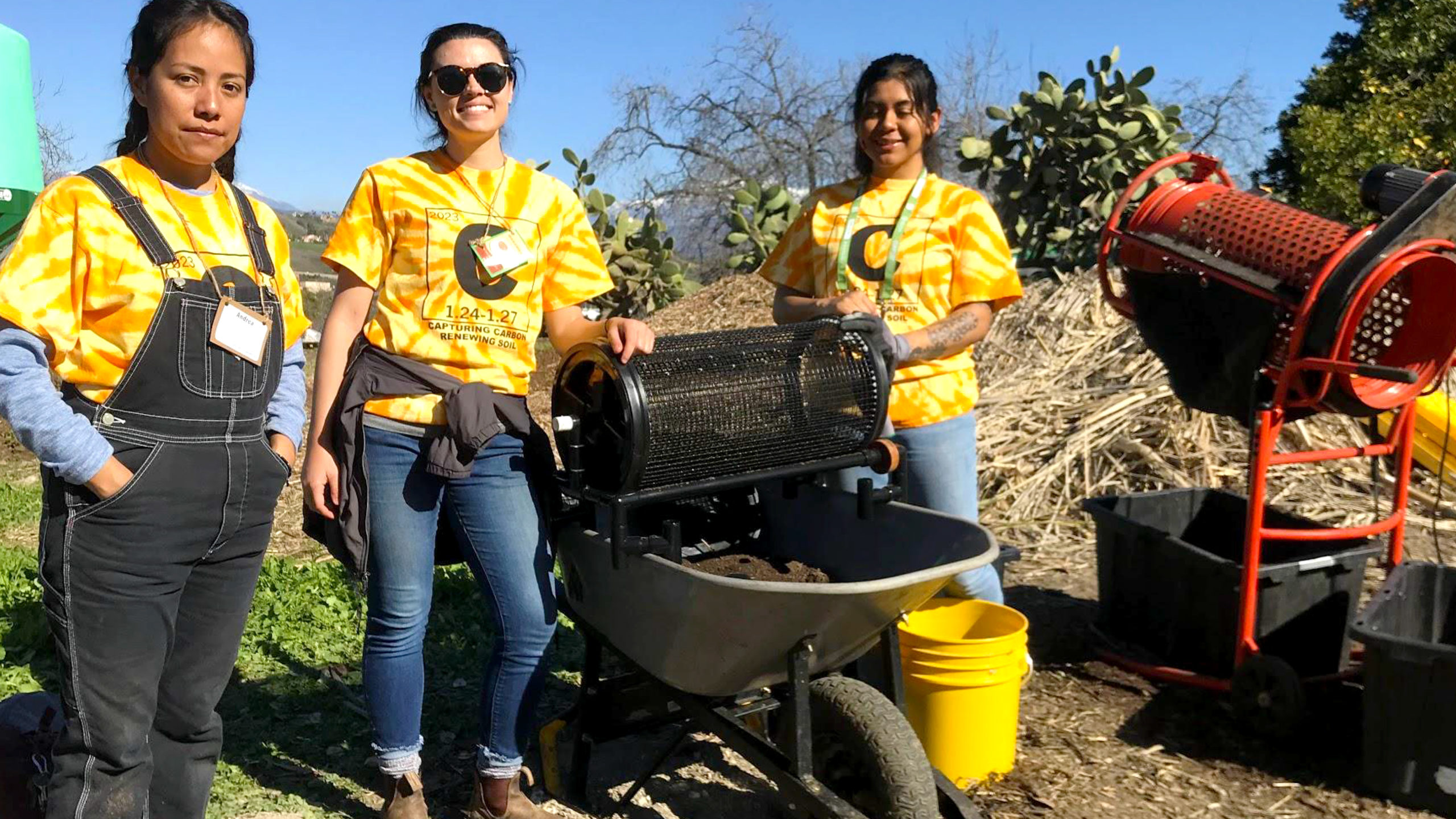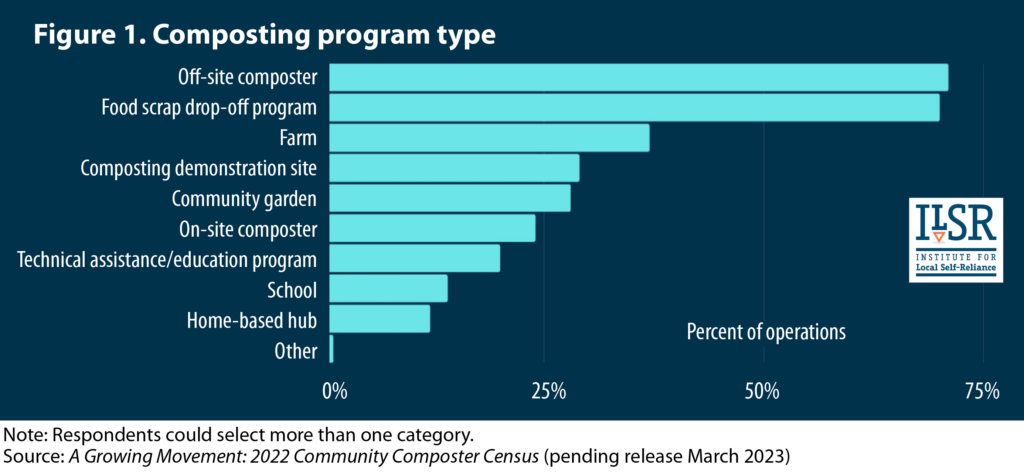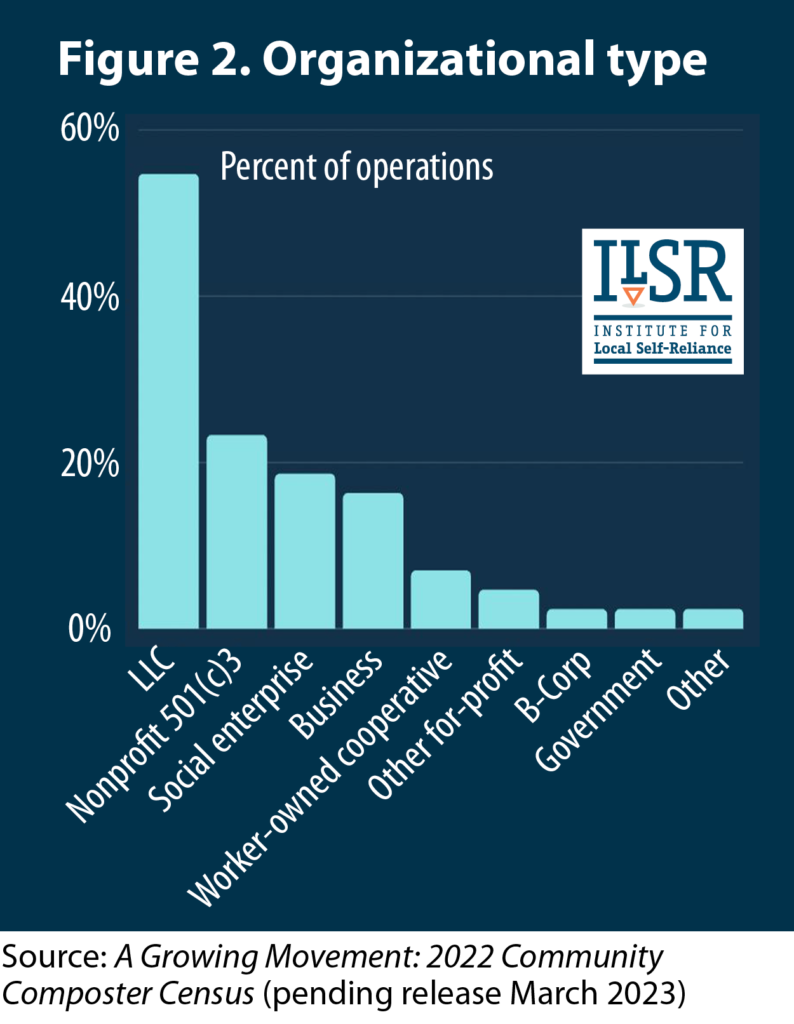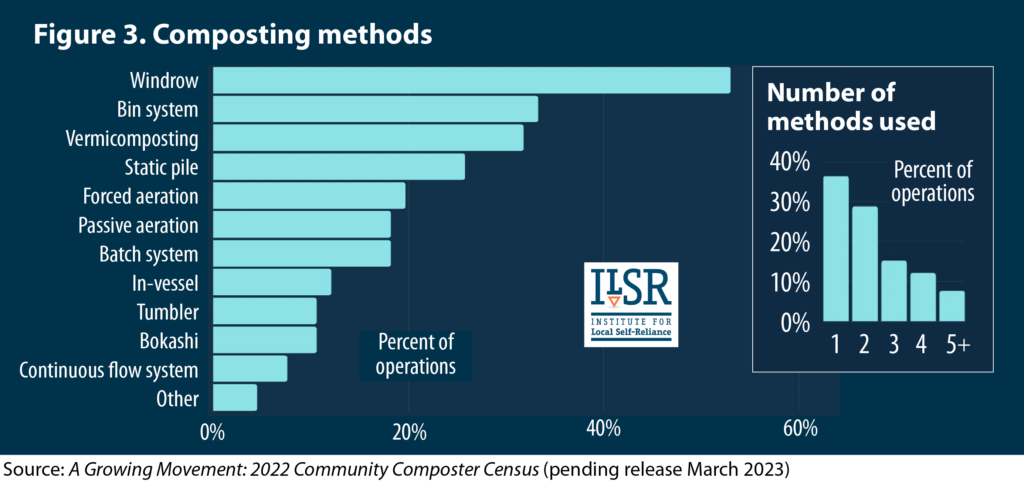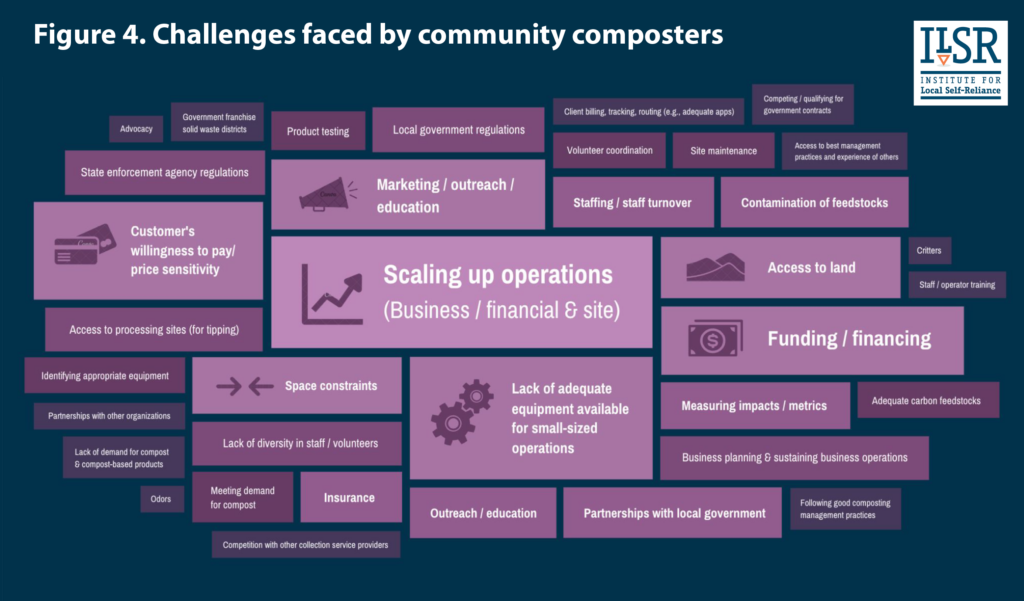Top: LA Compost staff showcase compost screeners at the Small Equipment Field Day, hosted at CalPoly Pomona’s Lyle Center for Regenerative Studies. From left: Andrea Torres, San Fernando Valley Compost Manager; Megan Laird, Development Manager; and Erica Montelongo, South LA Compost Manager. Photo courtesy ILSR
Brenda Platt
At the US Composting Council’s (USCC’s) annual conference, COMPOST2023, in Ontario, California in January, the presence of community composters was palpable. About one in ten of the 1,400 attendees identified as a community composter, meaning they are keeping the process and product as local as possible while engaging the community through participation and education. The Institute for Local Self-Reliance (ILSR) held its 7th National Cultivating Community Composting Forum & Field Day as preconference events. The Forum facilitated peer-to-peer learning, while the Field Day was the first USCC-sponsored event to feature small-sized equipment demonstrations.
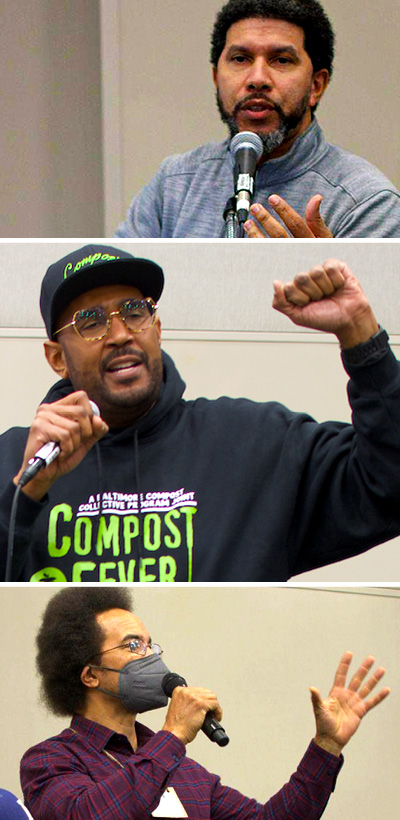
Nando Rodriguez, The Brotherhood Sister Sol & Open Road of NY (New York City), top; Marvin Hayes, Baltimore Compost Collective; and Jeffrey Neal of Loop Closing (DC), bottom, talk at the Forum about how to generate excitement in composting in urban chronically marginalized communities and engage youth, and build a community of practice. Photos courtesy ILSR
ILSR partnered with USCC in raising a record-breaking $49,600 in scholarship funding to bring diverse and community-oriented composters to the gathering. Of the 189 attendees at the Forum events, 83 received scholarships. As a result, COMPOST2023 had more diversity than previous national conferences — not only in terms of race, gender, and age, but also measured in participation by smaller-sized, mission-driven community benefit operations.
Frank Franciosi, USCC’s Executive Director, acknowledged that “community-scale composting is significant to building compost infrastructure at all scales” and pointed to having composters of all sizes as critical to the success of the conference. Community composters in attendance agreed.
“The significant representation of community composters shows how the movement is growing and how cities are utilizing small-size composters to help divert organics from the landfill and incinerator,” noted Brigid Gregory, with the Delaware Community Composting Initiative. Maya Shydlowski with the Compost Education Program in San Jose, California, commented on holding the Forum in conjunction with the USCC annual conference not only diversified the event but also allowed “community composters to have a voice and be clued in on what’s going on in commercial-scale composting.” Ryan Green of Happy Trash Can Curbside Composting in Bozeman, Montana, echoed these sentiments: “Having the Forum and the USCC annual conference back-to-back bridges the gap between the different scales of composting, which ultimately has the same goal — divert material from landfills and help replenish our soils.” Aramay Moss of Rust Belt Riders in Cleveland, Ohio, had her belief validated that “we have the knowledge and expertise to not only nationalize composting at scale, but to make that a movement worth scaling that embeds values of community, environmental justice, and equity.”
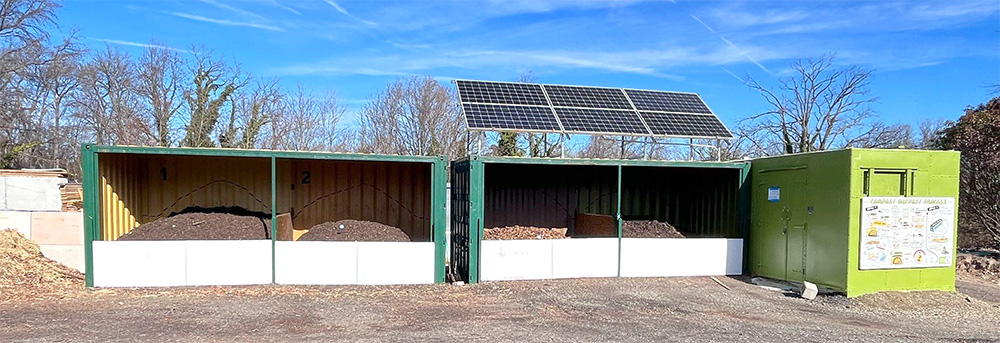
Shipping containers retrofitted into a solar-powered ASP system at ECO City Farms, an urban farm serving a food-insecure community in Bladensburg, Maryland. Photo courtesy ECO City Farms
Indeed, some community composters — such as Jeffrey Neal of Loop Closing in Washington, D.C. — take issue with labeling community composting “small scale” as it falsely implies that the sector cannot scale up. Community composting can scale up; that is, small-sized operations can be replicated in more places to form a distributed network that together can handle a substantial portion of a community’s organics. At the same time, a small-sized site can also increase its capacity to handle larger volumes and more types of materials more efficiently. For example, ECO City Farms in Bladensburg, Maryland did this by installing two retrofitted shipping containers and forming a partnership with Compost Crew, a Maryland-based food scraps collection enterprise. Previously, ECO City Farms relied on a 3-bin Compost Knox system retrofitted with blowers (to minimize labor), followed by “finishing” with a vermicomposting system. The container system increased efficiency and capacity.
Presentations given at the 7th National Forum are available at this link. Since the first Forum was convened in Columbus, Ohio in 2013 (by BioCycle!), community composting has greatly expanded. Today, ILSR facilitates a Community Composter Coalition with 272 organizational members in 42 states plus Washington, D.C., Puerto Rico, and 8 other countries. Growth in 2022 alone was 39%. Coalition member Xuehua Zhang of the Lishui Institute of Ecology & Environment at Nanjing University in China declared that “community composting is on the rise worldwide.”
A Growing Movement
ILSR’s new report, A Growing Movement: 2022 Community Composter Census (pending release later in March), underscores the rapid growth of this sector and its diversity. Operations span the country, often serving areas with no previous infrastructure for composting food discards (from Montana to Alabama and many places in between).
Figure 1, from ILSR’s upcoming Census, captures the percentage breakdown by program type. A vast majority of Census respondents identify as off-site composters — where material composted is largely sourced off-site — and as food scrap drop-off programs. Other types include farms, demonstration sites, community gardens, on-site composters (composting is done where the material is generated), schools, and home-based hubs.
Figure 2 shows the breakdown by organizational type. A quarter are nonprofits, and more than 15% identify as social enterprises, with a growing number of worker-owned cooperatives. Even the composting systems deployed vary considerably. Figure 3 indicates that windrows are the most popular method, followed by bin systems and vermicomposting. A majority employ multiple methods, with fewer than 40% utilizing only one. Small-sized and DIY (do it yourself) systems — which often use reclaimed materials — are faster and cheaper to build and replicate. The Composting Systems panel session at the Forum highlighted this point. Benny Erez of ECO City Farms described converting shipping containers into solar-powered aerated static pile (ASP) systems. Khari Diop with Think Green Inc. and Truly Living Well Center for Natural Urban Agriculture in Atlanta showcased his solar-powered hexagonal ASP system, designed to reduce volunteer burnout in managing piles. When programs are diverse, decentralized, and community-led, innovation and creativity often result.
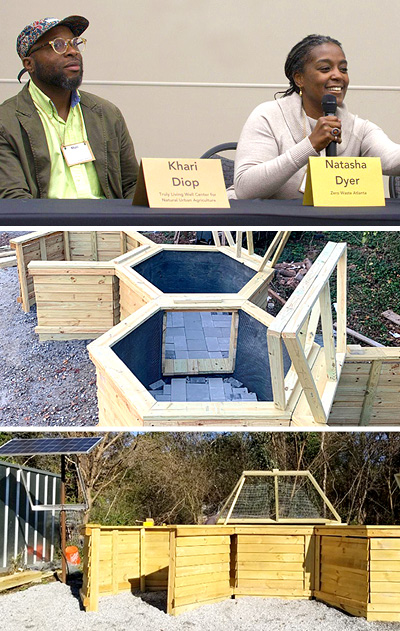
Khari Diop, Think Green Inc. and Truly Living Well Center for Natural Urban Agriculture, and Natasha Dyer, Zero Waste Atlanta discuss how moving toward solar-powered ASP community-engaged systems aims to reduce volunteer burn-out in Atlanta. Photos (above) show the system in the process of being built. Photos courtesy ILSR (top) and Khari Diop
Composting’s benefits to cut food loss, sequester carbon, enhance soil properties, and create jobs are increasingly recognized. Less well known are its benefits to improve food access, beautify neighborhoods, engage and educate the community, provide green spaces for gathering, boost psychological well-being, keep at-risk youth off the streets, and empower volunteerism. Presentation after presentation by community composters amplified these benefits, which are unique to local composting. After detailing how her program delivers these co-benefits, Elinor Crescenzi of the Food Cycle Collective in Pomona (part of a panel on California community composting) pointed out, “If you were to pay for all these environmental programs separately, we’d be looking at a very expensive ticket. You’re getting all of these alongside your diversion and climate benefits.”
Challenges To Scaling
With all these astounding pluses, you’d think policy makers would be tripping over themselves to invest in community composting. They’re not. ILSR’s Census identified numerous challenges: scaling up operations, funding and financing, access to land, and lack of adequately sized equipment, to name a few. These were also key takeaways of the California events. In her talk, Renee Wallace of FoodPlus Detroit decried how she is tired of poor soil, polluted air, and heat island effects, which are killing people and disproportionately impacting Detroiters’ quality of life. “We have a gap, we don’t have enough capacity,” she stated in calling for support for composting projects rooted in and serving the community. Conference attendee Prema Walker of Desert Compost in Palm Springs, California, lamented the fact that “community composters need more support and attention from the governing agencies.” In her acceptance speech for the Small-Scale Composter Manufacturer of the Year Award, Jamie Blanchard-Poling of Compost Queen in Ft. Collins, Colorado forcefully called on compost equipment manufacturers to meet the demand for appropriately sized equipment.

At the Field Day, Drew Felix of the Food Cycle Collective showcases a customized bike trailer rig made from reclaimed wood and metal bed frames (which can comfortably haul 600 lbs). The most expensive element was the E Bike kit (~$950). Photo courtesy ILSR
Meanwhile, California’s Governor Newsom incredulously dropped $4.8 million in funding for community composting. In her February 23rd BioCycle article, Why Community Composting Is Critical To California’s Infrastructure, Kourtnii Brown of the California Alliance for Community Composting eloquently articulated the substantive social and environmental impacts of community composting (at half the cost of larger commercial operations), while pointing out that community compost hubs in the state can’t keep pace with demand and are underfunded.
Elsewhere, community composters are also facing challenges (Figure 4). The Lower East Side Ecology Center and other groups in New York City have struggled to secure long term commitments from city agencies to continue operating their long-standing composting facilities on city-owned land. Peels & Wheels Composting in New Haven, Connecticut, just found out it is being booted off its site next month. And Michael Bradlee of The Community Compost Depot in Providence, Rhode Island, is frustrated that he has spent years meeting with Rhode Island state and city officials, applying for grants, pioneering food scrap drop-off depots and urban composting in the state, but to no avail when it comes to securing needed funds.
Too often, community composters are viewed as a minor solution to waste problems. Yet, with adequate investment and support, community composting can scale up to serve an integral and significant role. Marvin Hayes of the Baltimore Compost Collective closed out the 2023 Cultivating Community Composting Forum presenting his powerful poem about the fight to close Baltimore’s incinerator and how composting brought his community together. Part of his poem makes an apt ending here too: “So I ask you, how long will this environmental injustice last? We don’t have much time, climate change is happening fast. Composting is a member of this supporting cast.”
Brenda Platt is Director of the Composting for Community Initiative at the Institute for Local Self-Reliance, a national nonprofit founded in 1974. This Initiative is catalyzing decentralized local composting to cut food loss, enhance soils, support local food production, and protect the climate while addressing community prosperity and equity issues. The initiative’s team engages in policy research and advocacy, offers composting training and education, releases guides of best practices and model programs, and convenes a national community composter coalition. ILSR’s 2023 Cultivating Community Composting Forum & Field Day was sponsored by 11th Hour Project, a program of the Schmidt Family Foundation, the US Composting Council, Biobag, BioCycle, Green Mountain Technologies, Reotemp, WeRadiate, and Adk Action/Compost for Good. LA Compost and Food Cycle Collective provided critical support; together they brought more than 20 volunteers to staff the Field Day. More details on the events, including presentations and short videos, can be found on ILSR’s website. Biocycle CONNECT’s next issue will conclude this 2-part article series from ILSR with more data on ILSR’s upcoming report, A Growing Movement: 2022 Community Composter Census.


